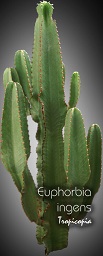Table of contents
Giant Candelabra tree

Latin Name: Euphorbia ingens
Category: Cactus & Succulent
Family: Euphorbiaceae
Origin: South Africa
Climate: Arid Tropical
Growing Zones: 11-10
Care Instructions
The Giant Candelabra tree (Euphorbia ingens) is a arid tropical plant that originates from South Africa. This cactus & succulent plant belongs to the Euphorbiaceae family and is well-suited for growing in USDA zones 11-10.
Complete Care Guide for the Giant Candelabra Tree (Euphorbia ingens)
Watering Requirements
The Giant Candelabra Tree, or Euphorbia ingens, is a succulent that thrives in arid conditions, making its watering requirements quite specific. It is crucial to allow the soil to dry out completely between waterings. During the growing season, which typically spans from spring to early fall, water the plant every 2-3 weeks, ensuring that excess water drains away to prevent root rot. In the winter months, reduce watering to once a month or even less, as the plant enters a dormant phase. Always check the soil moisture before watering; if the top 2-3 inches of soil feel dry, it’s time to water. Overwatering is one of the most common mistakes made with this species, so err on the side of caution.
Light Conditions
The Giant Candelabra Tree requires bright, indirect sunlight to thrive. Ideally, it should be placed in a location where it can receive at least 6 hours of sunlight each day. A south-facing window is often the best choice for indoor plants. If grown outdoors, ensure it is in a spot that receives full sun but is protected from harsh afternoon rays, especially in extremely hot climates. While Euphorbia ingens can tolerate some shade, insufficient light can lead to leggy growth and a weakened plant. If you notice the plant stretching towards the light, it may be a sign that it needs more exposure to sunlight.
Soil Preferences
This succulent prefers well-draining soil that mimics its native arid environment. A cactus or succulent potting mix is ideal, but you can also create your own by mixing regular potting soil with sand and perlite in equal parts. This combination ensures that excess moisture drains away quickly, preventing root rot. Additionally, consider adding a slow-release fertilizer during the growing season to provide essential nutrients. Fertilizing every 4-6 weeks with a diluted, balanced fertilizer can promote healthy growth. However, avoid fertilizing during the winter months when the plant is dormant.
Pests and Diseases
The Giant Candelabra Tree is relatively resistant to pests and diseases, but it can still be affected by common issues such as mealybugs, spider mites, and scale insects. Regularly inspect the plant for any signs of infestation, such as webbing or sticky residue. If you notice pests, treat them promptly with insecticidal soap or neem oil, ensuring to cover all surfaces of the plant. Additionally, be cautious of overwatering, as this can lead to root rot and fungal diseases. If you suspect root rot, remove the plant from its pot, trim away any affected roots, and repot it in fresh, dry soil.
Special Care Tips
To maintain the health and beauty of your Giant Candelabra Tree, consider the following special care tips. First, always wear gloves when handling the plant, as its milky sap can be irritating to the skin and toxic if ingested. If you need to prune the plant, do so in the spring to encourage new growth. Additionally, ensure that the pot has drainage holes to prevent water accumulation. If you live in a region with cold winters, it’s best to bring the plant indoors to protect it from frost. Lastly, consider rotating the plant every few weeks to ensure even growth and exposure to light. With proper care, your Euphorbia ingens can thrive and become a stunning focal point in your garden or home.








